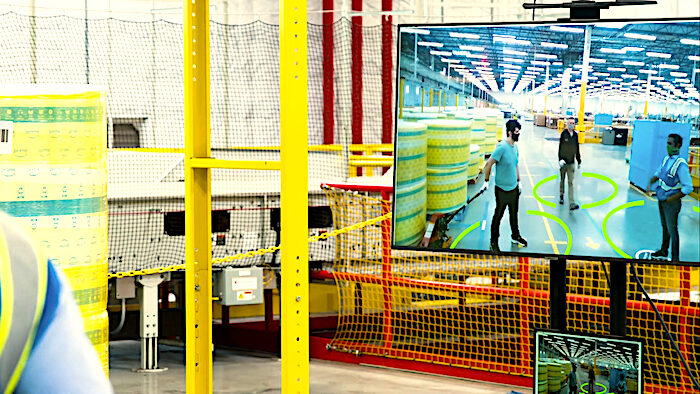
The 1 million-square-foot facility located about 20 miles south of Seattle is the site of a new wearable technology device to enforce prescribed COVID-19 social distancing rules. As described, the device itself doesn't exactly seem to be state-of-the-art. A "clear plastic sleeve" with an LED light and a small audio system will alert warehouse personnel if they are too close for coronavirus comfort.
The idea is to startle workers who may inadvertently (or purposely) violate social distancing rules with flashing lights and digital alarm bells to elicit a Pavlovian response from them. The rationale, of course, is to prevent the spread of COVID-19. But, there is more just day-to-day workplace safety involved in this Orwellian application of technology straight out of Fritz Lang's Metropolis.
In the case that an employee is found to have contracted the virus - as happened in March at this very facility -, the rudimentary tech device will also collect data of the person's exact whereabouts throughout the work day and provide management with specific information about who the infected worker came into close contact with, determining who must undergo contact tracing protocols.
Privacy issues or workplace rights are now totally bypassed in the age of COVID-19. Testing and the ostensible development of the device came as a result of pressure from multiple State governments this past May when 13 Attorney Generals called on Amazon and its subsidiary Whole Foods to implement stricter protection policies.
Selective Problem Solving
The pressure brought on the online retail giant by attorney generals from Massachusetts to New Mexico cites lapses in Amazon's "policies and processes that relate to notifying people of coronavirus developments at its stores," noting that "Many of our States' consumer protection laws require businesses to provide truthful information and disclose material information to consumers" in a letter sent to Whole Foods' CEO, John Mackey.
However, Amazon's quick implementation of a solution to the state's requests speaks to the direct interest he has in relation to such technologies, as opposed to the more structural problems at his facilities many have been complaining about for much longer.
Tim Bray, a former vice president at the company, resigned in May over Amazon's decision to fire several employees who dared to publicly criticize its record on climate change and workplace conditions. Maren Costa's 15-year career at Amazon was let go in April after speaking out about the company's ecological footprint. Her colleague, Emily Cunningham, was also fired. They and a third employee had founded "Amazon Employees for Climate Justice" and were planning a virtual rally that same month.
Costa acknowledged that Amazon had previously warned her about her activism, but stated that she had "no regrets" over standing up for her beliefs. Amazon has so far ignored calls by advocacy groups to re-instate her and her former colleagues. Innovations to further control workers through devices like the one now being tested in Kent, however, have gained plenty of traction in upper management circles.
The Not-So-New New Normal
Other techniques to enforce social distancing are being rolled out in different facilities. An alternate open source software program that uses augmented reality called "Distance Assistant" is being introduced across multiple facilities.
The solution leverages earlier applications, which used machine learning and artificial intelligence to "help site leaders identify high traffic areas". The Distance Assistant uses a stand-alone monitor that displays on-screen indicators to "remind and encourage associates to maintain appropriate distance from others."
Amazon foresees these kinds of technologies proliferating in the near future as workplaces like theirs continue to shift into a "new normal" where human beings surrender their own cognitive functions over to the machine and rely on an algorithm to put one foot in front of the other. Amazon has begun deploying "hundreds of these units" over the following weeks and, at least one still-employed vice president and engineer, looks forward to other companies following suit and building their own version of the "Distance Assistant".
This, together with the device being tested at the Kent facility augurs an ever-more intrusive workplace environment as corporations simultaneously increase their monopoly power and take advantage of the social panic caused by the pandemic to retrofit their business concerns with the most draconian surveillance and tracking technologies they can think of.
About the Author:
Raul Diego is a MintPress News Staff Writer, independent photojournalist, researcher, writer and documentary filmmaker.



Reader Comments
You must really like cocktails.
try to scream - but no one will hear you. R.C.
They make this tech seem so useful and benign but there is an insidious and invasive underbelly.